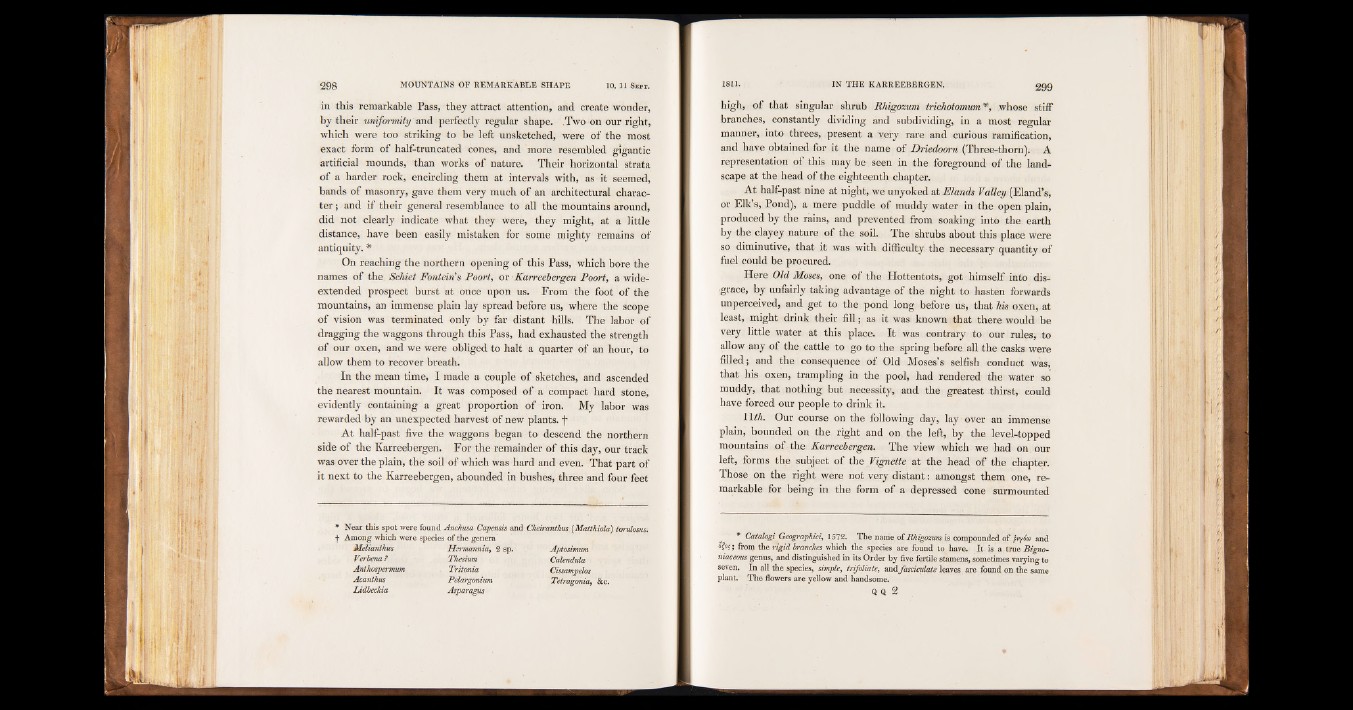
in this remarkable Pass, they attract attention, and create wonder,
by their uniformity and perfectly regular shape. .Two on our right,
which were too striking to be left unsketched, were of the most
exact form of half-truncated cones, and more resembled gigantic
artificial mounds, than works of nature. Their horizontal strata
of a harder rock, encircling them at intervals with, as it seemed,
bands of masonry, gave them very much of an architectural character
; and if their general resemblance to all the mountains around,
did not clearly indicate what they were, they might, at a little
distance, have been easily mistaken for some mighty remains of
antiquity. *
On reaching the northern opening of this Pass, which bore the
names of the Schiet Fmtein's Poort, or Karreebergen Poort, a wide-
extended prospect burst at once upon us. From the foot of the
mountains, an immense plain lay spread before us, where the scope
of vision was terminated only by far distant hills. The labor of
dragging the waggons through this Pass, had exhausted the strength
of our oxen, and we were obliged to halt a quarter of an hour, to
allow them to recover breath.
In the mean time, I made a couple of sketches, and ascended
the nearest mountain. It was composed of a compact hard stone,
evidently containing a great proportion of iron. My labor was
rewarded by an unexpected harvest of new plants, f
At half-past five the waggons began to descend the northern
side of the Karreebergen. For the remainder of this day, our track
was over the plain, the soil of which was hard and even. That part of
it next to the Karreebergen, abounded in bushes, three and four feet
* Near this spot were found Anckusa Capensis and Cheiranthus (Matthiola) tandosus.
f Among which were species of the genera
Melianthus
Verbena?
Anthospermum
Acanthus
Lidbeckia
Hermanniay
Thesium
Tritonia
Pelargonium
Asparagus
2 sp. Aptosimum
Calendula
Cissampelos
Tetragonia, &c.
high, of that singular shrub Rhigozum trichotomum*, whose stiff
branches, constantly dividing and subdividing, in a most regular
manner, into threes, present a very rare and curious ramification,
and have obtained for it the name of Driedoom (Three-thorn). A
representation of this may be seen in the foreground of the landscape
at the head of the eighteenth chapter.
At half-past nine at night, we unyoked at Elands Valley (Eland’s,
or Elk’s, Pond), a mere puddle of muddy water in the open plain,
produced by the rains, and prevented from soaking into the earth
by the clayey nature of the soil. The shrubs about this place were
so diminutive, that it was with difficulty the necessary quantity of
fuel could be procured.
Here Old Moses, one of the Hottentots, got himself into disgrace,
by unfairly taking advantage of the night to hasten forwards
unperceived, and get to the pond long before us, that his oxen, at
least, might drink their fill; as it was known that there would be
very little water at this place. It was contrary to our rules, to
allow any of the cattle to go to the spring before all the casks were
filled; and the consequence of Old Moses’s selfish conduct was,
that his oxen, trampling in the pool, had rendered the water so
muddy, that nothing but necessity, and the greatest thirst, could
have forced our people to drink it.
1 Ith. Our course on the following day, lay over an immense
plain, bounded on the right and on the left, by the level-topped
mountains of the Karreebergen. The view which we had on our
left, forms the subject of the Vignette at the head of the chapter.
Those on the right were not very distant: amongst them one, remarkable
for being in the form of a depressed cone surmounted
' * Catalogi G e o g r a p h ic 1572. The name o f Rhigozum is compounded of piyow and
o fa ; from the rigid branches which the species are found to have. I t is a true Bigno-
niaceous genus, and distinguished in its Order by five fertile stamens, sometimes varying to
seven. In all the species, simple, trifoliate, and fasciculate leaves are found on the same
plant. The flowers are yellow and handsome.